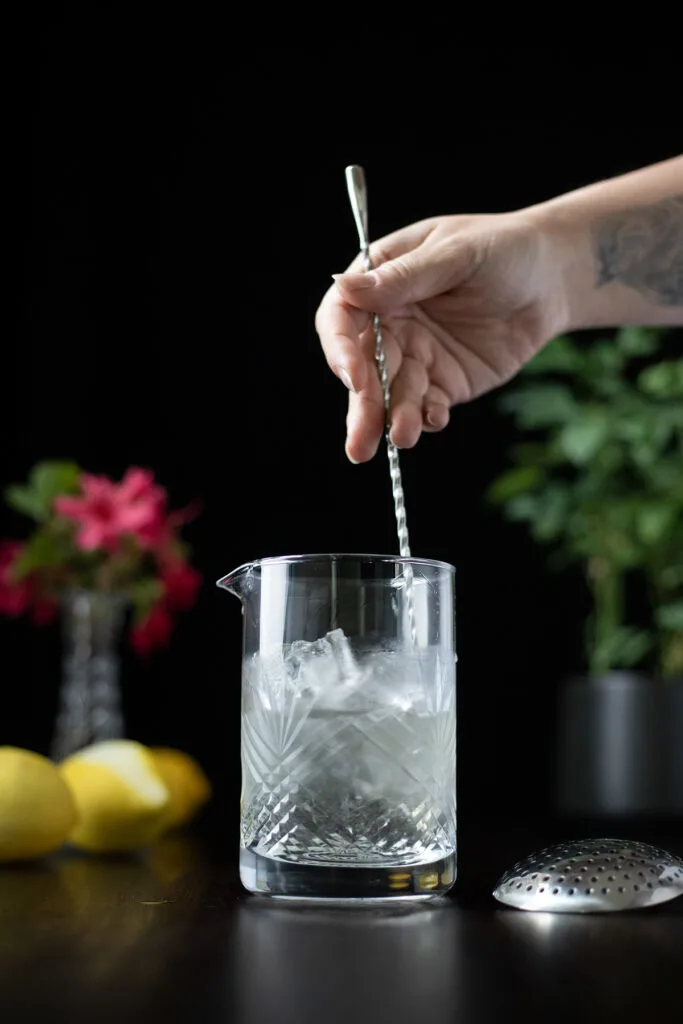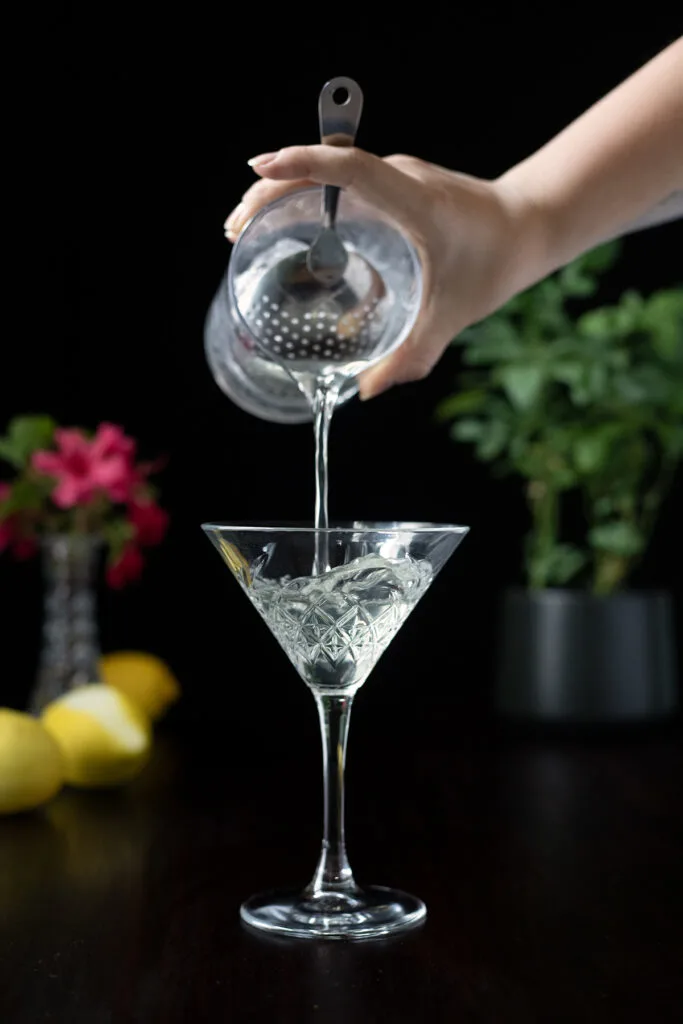The Martini is the single most iconic cocktail of all time. The sleek, triangular cocktail glass and its three skewered green olives are instantly recognizable the world over. How did this simple, three ingredient gin cocktail become so famous? Let’s dive into the story of the classic gin Martini and the many cocktails it inspired.

The history of the iconic cocktail
Like so many classic cocktails, no one really knows who invented the Martini or where it was first made. The drink emerged some time during the late 1800s, and it’s believed that it was a riff on the classic Martinez.
The Martinez is a mix of gin (originally the sweetened style, Old Tom gin) and sweet vermouth with a small amount of maraschino liqueur and a dash of bitters. This sweet and herbal sip evolved from the classic Manhattan (rye whiskey, sweet vermouth, bitters).
A drink called the Marguerite first appeared in 1900 in the Bartender’s Manual by famed bartender Harry Johnson. This cocktail reads very much like a modern dry Martini. This has led some to believe that the vermouth brand often featured in that recipe (Martini & Rossi) gave the Marguerite the name we know it by today.
For further reading on the history of the Martini and its predecessors, visit Difford’s Guide’s Martini History and Its Evolution.
Gin vs. vodka
The Martini was thought of as only a gin cocktail until vodka became widely distributed in the United States during the 1950s. Vodka’s complete lack of flavor and aroma was appealing to American drinkers and the Vodka Martini became even more popular than the original.
Vodka’s popularity grew and grew, peaking in the 1980s with famous cocktails like the Cosmopolitan and the Espresso Martini. Today, both the gin and the vodka Martini are popular options, so it’s best to specify your spirit of choice when ordering on in a bar.
Sidenote: the vodka version is technically known as a Kangaroo.
The best gins for a classic Martini
The Martini is one of the best simple cocktails for appreciating the full flavor of your gin. Choose a high quality gin with a flavor profile you enjoy. You don’t have to spend a lot of money to buy a quality gin. A good budget option is Bombay Sapphire, which is great-tasting and clocks in at about $25-$30 a bottle.
There’s no right or wrong choice, but classic London dry gins are the traditional choice for Martinis. You can also choose to use citrus-forward or floral gins in a Martini, but skip flavored or sweetened gins.

The Martini is a dry cocktail that leans citrusy, herbal, or savory, so classic juniper-forward gins are the preferred style. If using a gin with a non-traditional flavor profile, consider garnishing to accompany that gin’s botanicals. A lemon twist is often preferred to olives when using a more floral gin.
Some excellent gins for making a classic Martini include:
Sipsmith, Tanqueray No.10, Plymouth, Martin Miller’s, and Bombay Sapphire.
Dry vermouth: what it is and how to keep it fresh
Dry vermouth is a fortified, flavored wine. It has a characteristically dry (not at all sweet), herbal flavor. Vermouth acts as a modifier in the classic Martini, meaning that it softens and opens up the flavors of the gin.
Only a small amount of vermouth is used, but you will still taste it, so choose a quality brand like the flavorful Noilly-Prat or the more subdued Dolin. Part of the fun of making Martinis is finding the pairing of gin and vermouth that you enjoy best.
Vermouths do not last nearly as long as liquors or liqueurs and they should be stored in the refrigerator once opened. Unopened, store the bottle in a cool, dry place away from sunlight. Once opened, keep it in the fridge and use it or toss it within three months.
In my experience, an old bottle of dry vermouth doesn’t tend to taste bad, it will just become a bit lackluster, flavorless, or somewhat sour. If it looks funny or tastes off, start a fresh bottle.
The bitters debate
The traditional gin Martini has a dash of orange bitters. This bright, citrus flavor adds depth to the aroma of the drink and it complements the fresh, forest-like flavors of the gin, and the herbal layers of the vermouth. Orange bitters round out and add subtle nuance to the flavors of the Martini.
Although bitters are a traditional ingredient, many Martini drinkers (and bars) skip them. Some say that the bitters are necessary to make the drink a proper Martini, while others say that the bright orange notes detract from the more subtle flavors of the gin.

Like choosing the right gin or dry vermouth, deciding whether to add bitters or not is personal preference. Try it with and without and see which is right for you and your spirit of choice.
Tip: If you don’t have orange bitters or don’t want to use them, you can also experiment with expressing an orange peel (in place of and in addition to a lemon peel) for the garnish.
Garnish: lemon peel or olives
The iconic Martini is garnished with one or three green olives. A salty, vinegary olive is an excellent garnish for this dry cocktail, but you can also opt for a lemon twist. Lemon oils add incredible freshness that complements the botanical aromas of the gin.
If using olives, go for large, plump olives that are stuffed with pimento, or even blue cheese! Experimenting with different types of olives is a fun way to personalize your Martini. Spanish queen or Spanish Manzanilla olives are the most common Martini garnishes. Castelvetrano olives are another great option, although they’re a bit more mild.
Garnish your Martini with a cocktail onion and you’ve got yourself a Martini variation called the Gibson. A Gibson is often made slightly wetter (more vermouth).
How to order a Martini at a bar
Now that you understand the components of a Martini, let’s dive into the ways you can personalize this classic when ordering one out.
SPIRIT: Because both gin and vodka are popular options, be sure to specify which spirit, and even which brand, if you know the bar has it. If you don’t request a certain brand, you’ll be given whatever the bar’s “well” bottle is, which might not be your favorite.
STYLE: Next you can specify if you’d like the drink to be prepared dry, wet, or dirty. These are customizations, so you don’t have to state one when ordering your drink. But if you know you like it a certain way, it’s helpful to mention it to the bartender.
A classic Martini is already a Dry Martini, so there’s really no need to specify “dry” unless you want very little vermouth. And although it’s a popular joke that the vermouth in a Martini is somehow superfluous, it’s not. Without the vermouth, you’d just be left with a harshly boozy glass of watered down gin.
Requesting a “wet” Martini will get you one with a larger proportion of vermouth, while a “dirty” Martini is one that has olive brine added for salinity.
PREPARATION: Thanks to James Bond, it’s not uncommon to request that your Martini be shaken – or stirred, for that matter. More on that below.
GARNISH: Lastly, you can request your preferred garnish – olives or a lemon twist.
Examples: I’d like a wet Plymouth martini with olives. I’ll have a shaken vodka Martini with a twist.
Stirred, not shaken
A traditional Martini should be stirred with plenty of ice until thoroughly chilled, then strained into a chilled cocktail glass. A shaken Martini is also known as a Bradford. This style of Martini was popularized by James Bond with his Vesper Martini, but the concept of a shaken Martini has been around for over 100 years. The “Bradford a la Martini” shaken gin cocktail first appeared in Harry Johnson’s Bartender’s Manual in 1900.

As with all elements of the Martini, personal preference should dictate how it’s made. Some prefer to shake their Martinis for the extra dilution it can lend. However, because the drink contains no juices, cream, or eggs, the “proper” method of preparation is to stir.
Cocktails that are made with only spirits, liqueurs, wines, syrups, and bitters don’t need the extra agitation of shaking to fully incorporate the ingredients. Also, shaking adds a lot of air and loads of tiny ice shards to the drink. Both of these things detract from the silky smooth texture of the cocktail.
Martini variations
- Dirty Martini: made with a splash of olive brine.
- Wet Martini: made with a longer pour of vermouth. This makes a more herbal, slightly less boozy drink. Vermouth lovers will appreciate wet Martinis.
- Perfect Martini: made with gin and equal parts sweet and dry vermouth.
- Reverse Martini: made with a reversed ratio of gin to vermouth. This is a great lower-ABV way to enjoy the flavors of a Martini.
- Gibson Martini: A gin Martini garnished with a cocktail onion.
- Vesper Martini: James Bond’s personalized Martini specs, made with both gin and vodka.
- Kangaroo: the traditional (and rather strange) name for a Vodka Martini.
How to prepare an expertly crafted classic Martini
To achieve the best possible cocktail, first be sure to accurately measure your gin and vermouth. Use a jigger with pour lines rather than a shot glass. Add the ingredients to a mixing glass (a pint glass works well in a pinch) and fill the glass about three quarters with ice fresh from the freezer.
Now, use a long-handled bar spoon to stir, cradling the ice with the spoon and gently swirling it through the liquid. Aim to stir about thirty times. You’ll usually know your Martini is ready when the outside of the glass begins to frost over.

Place a Julep (Hawhthorne-style is fine too) strainer over the glass and strain the liquid into a chilled martini or coupe glass. Freeze your glasses ahead of time or chill them quickly by placing ice cubes and water in the glass while you prepare your drink. Discard the ice water just before straining.
If garnishing with lemon, express the peel over the surface of the drink and then run it along the rim of the glass. You can drop the peel into the drink, or discard it. If garnishing with olives, place one or three on a cocktail pick and rest it inside the glass.


Classic Gin Martini
Ingredients
- 2½ oz gin
- ½ oz dry vermouth
- 1 dash orange bitters (optional)
Instructions
- Combine all ingredients in a mixing glass and fill it 3/4 with ice.
- Stir until well chilled, about 30 times.
- Strain the liquid into a chilled cocktail glass and garnish with olives or a lemon twist.
